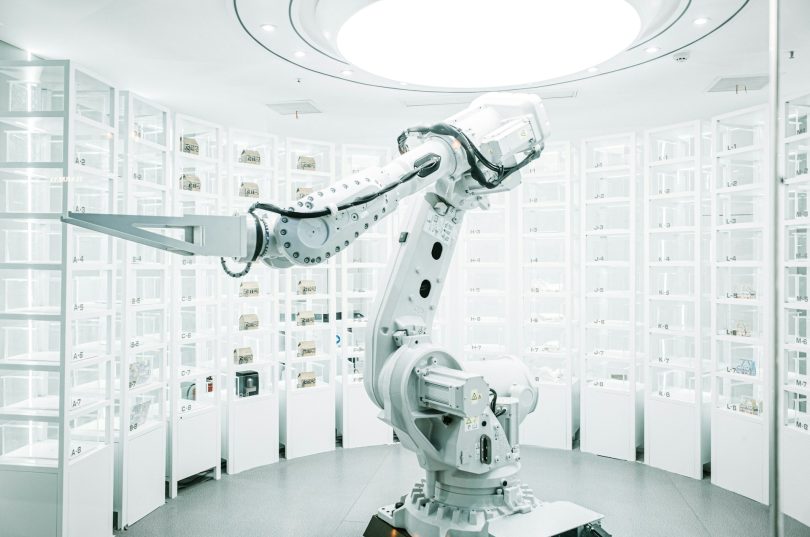The Evolution of Modern Industry
The world is witnessing a massive transformation in how goods are produced, assembled, and delivered. This revolution is known as Industry 4.0 the fourth industrial revolution — driven by advanced technologies such as artificial intelligence (AI), the Internet of Things (IoT), big data, cloud computing, and, most importantly, robotics.
Robots have evolved far beyond the mechanical arms once confined to car assembly lines. Today’s robots are intelligent, adaptable, and interconnected, capable of collaborating with humans, learning from data, and performing complex tasks with precision. The fusion of robotics with digital technology lies at the heart of Industry 4.0, ushering in an era of smart factories, automated systems, and unprecedented efficiency.
This article explores the role of robotics in Industry 4.0, its applications, benefits, challenges, and the future of automated industrial ecosystems.
Understanding Industry 4.0: The Fourth Industrial Revolution
To appreciate the role of robotics, it’s important to understand what Industry 4.0 means.
The Four Industrial Revolutions
-
Industry 1.0 (Late 18th Century): Introduction of steam engines and mechanized production.
-
Industry 2.0 (Late 19th Century): Mass production and assembly lines powered by electricity.
-
Industry 3.0 (Mid 20th Century): Automation using computers, electronics, and early robotics.
-
Industry 4.0 (21st Century): Intelligent automation powered by AI, IoT, robotics, and real-time data analytics.
In Industry 4.0, physical machines are connected to digital networks, enabling them to communicate, analyze, and make autonomous decisions. This integration creates a cyber-physical system where digital intelligence meets mechanical precision — and robotics plays the central role in bringing this concept to life.
What Are Industrial Robots?
Industrial robots are programmable machines designed to perform specific tasks with speed, accuracy, and consistency. Traditionally, they have been used for repetitive or dangerous jobs, such as welding, painting, or packaging. However, in Industry 4.0, robots have become smarter, interconnected, and capable of decision-making through AI and data integration.
Modern industrial robots can now:
-
Learn from data using machine learning algorithms.
-
Interact safely with humans through collaborative robotics (cobots).
-
Communicate with other machines using IoT systems.
-
Adapt to dynamic production needs through real-time analytics.
These advancements have made robotics an indispensable pillar of the Industry 4.0 ecosystem.
The Integration of Robotics in Industry 4.0
In Industry 4.0, robotics isn’t just about performing mechanical tasks — it’s about creating intelligent systems that communicate and evolve. The integration of robotics involves multiple layers of technology working together.
1. Artificial Intelligence (AI) and Machine Learning
AI allows robots to analyze data, recognize patterns, and make autonomous decisions. Machine learning enables them to improve performance over time, learning from previous operations to optimize future ones.
For example, a robotic arm in a manufacturing plant can adjust its speed, angle, or grip based on product quality feedback, ensuring consistent precision.
2. The Internet of Things (IoT)
IoT connects robots with other devices, sensors, and systems through the internet. This enables seamless communication between machines, resulting in real-time monitoring, predictive maintenance, and process optimization.
3. Big Data and Analytics
Robots generate vast amounts of data — about performance, productivity, and energy consumption. Through big data analytics, industries can use this information to identify bottlenecks, forecast failures, and improve efficiency.
4. Cloud Computing
Cloud-based platforms allow robots to access shared data and processing power remotely. This not only reduces the cost of infrastructure but also enhances flexibility, scalability, and collaboration between different production sites.
5. Human-Robot Collaboration (Cobots)
Unlike traditional robots that worked in isolation, collaborative robots (cobots) are designed to work safely alongside humans. They combine human creativity with robotic precision, increasing overall productivity and adaptability.
Applications of Robotics in Industry 4.0
The role of robotics spans multiple industries — from manufacturing to logistics, healthcare, and beyond. Below are key areas where robotics is revolutionizing industrial operations.
1. Manufacturing and Assembly
Manufacturing remains the biggest beneficiary of robotics. Smart factories now use robots for assembly, welding, painting, and packaging. AI-powered robots can adjust production processes automatically, detect defects, and ensure consistent product quality.
2. Logistics and Supply Chain
Warehouse robots have become essential for handling inventory, sorting, and packaging. Systems like Automated Guided Vehicles (AGVs) and Autonomous Mobile Robots (AMRs) navigate complex warehouse layouts, reducing errors and delivery times.
3. Automotive Industry
Robotics has long played a crucial role in car manufacturing, but with Industry 4.0, vehicles and robots are now connected. Robots can weld, paint, and even inspect vehicles with computer vision. They work side-by-side with humans to customize designs and handle quality assurance.
4. Healthcare and Pharmaceuticals
Robotics in healthcare is growing rapidly. Robots assist in surgeries, dispense medications, and even transport medical supplies within hospitals. In pharmaceutical manufacturing, robots ensure sterile, precise, and contamination-free operations.
5. Agriculture
Agricultural robots, or “AgriBots,” perform soil analysis, planting, harvesting, and irrigation management. With IoT and AI integration, they analyze environmental data to optimize yield and resource use.
6. Construction
In the construction sector, robots are used for bricklaying, welding, 3D printing of structures, and site inspections. They enhance worker safety and speed up project completion.
7. Aerospace and Defense
Aerospace manufacturing requires extreme precision. Robotics assists in assembling complex aircraft components, inspecting materials, and performing maintenance tasks that would be too dangerous or intricate for humans.
Advantages of Robotics in Industry 4.0
1. Enhanced Productivity and Efficiency
Robots can work continuously without fatigue, achieving higher productivity levels than human labor. They can perform repetitive or dangerous tasks with speed and accuracy, allowing human workers to focus on strategic and creative roles.
2. Improved Quality and Precision
Robots perform tasks with consistent accuracy, minimizing errors and waste. In industries like electronics or pharmaceuticals, where precision is critical, robots ensure uniformity and compliance with standards.
3. Flexibility and Adaptability
Modern robots are highly flexible and can be reprogrammed to handle multiple tasks. This adaptability allows manufacturers to respond quickly to changes in demand, product design, or production volume.
4. Cost Reduction
While the initial investment in robotics is high, the long-term savings from reduced labor costs, waste, and downtime make it a cost-effective solution. Predictive maintenance and automation also minimize repair costs.
5. Enhanced Safety
By taking over hazardous tasks such as welding, lifting heavy objects, or working with toxic materials, robots reduce the risk of workplace injuries, ensuring a safer environment for human workers.
6. Real-Time Decision Making
Through IoT and AI integration, robots collect real-time data that helps managers make informed decisions. They can predict machine failures, optimize production schedules, and improve workflow efficiency.
Read More: The Internet of Things: Connecting the World One Device at a Time
Challenges and Limitations of Robotics in Industry 4.0
1. High Initial Costs
Implementing robotics and smart systems requires substantial investment in equipment, software, and training, making it challenging for small and medium enterprises (SMEs).
2. Job Displacement
Automation has raised concerns about job losses, particularly in labor-intensive sectors. While robots create new technical roles, they may reduce the demand for certain manual jobs.
3. Cybersecurity Threats
As robots become connected through IoT, they are vulnerable to hacking, data theft, and system breaches. Ensuring cybersecurity is critical for maintaining operational safety and data integrity.
4. Complexity of Integration
Integrating robotics with legacy systems, ensuring interoperability, and managing data flow across platforms can be complex and costly.
5. Ethical and Regulatory Issues
The use of AI-driven robots raises questions about accountability, data privacy, and ethical decision-making — especially when robots are involved in critical operations like healthcare or defense.
Human-Robot Collaboration: Building the Smart Workforce
One of the most exciting aspects of Industry 4.0 is the rise of human-robot collaboration. Rather than replacing humans, robots are designed to augment human capabilities.
Cobots can assist workers in lifting heavy components, handling precision tasks, or performing repetitive actions, allowing humans to focus on problem-solving and innovation. This collaboration is paving the way for smart factories, where humans and machines coexist harmoniously, combining efficiency with creativity.
In addition, new jobs are emerging in robot programming, maintenance, data analysis, and AI development, reshaping the industrial workforce into a more skilled and technology-driven community.
The Future of Robotics in Industry 4.0
The future of robotics in Industry 4.0 looks incredibly promising. Several trends are shaping the next phase of industrial automation:
1. Artificial Intelligence Integration
Robots will become even smarter as AI continues to advance. They’ll be capable of self-learning, self-correction, and autonomous decision-making, minimizing human intervention.
2. Edge Computing and 5G Connectivity
With faster communication through 5G and edge computing, robots will be able to process data locally, enabling real-time decision-making and seamless coordination.
3. Cloud Robotics
Cloud robotics allows robots to access massive computational resources remotely, share data, and learn from each other — making automation more efficient and scalable.
4. Swarm Robotics
Inspired by nature, swarm robotics involves large numbers of small robots working together to complete complex tasks, such as warehouse sorting or disaster response.
5. Sustainability and Green Robotics
Future robots will focus on energy efficiency, recycling, and sustainability. They’ll help industries reduce waste, optimize resource use, and support environmental goals.
6. Integration with Digital Twins
A digital twin is a virtual model of a physical system. Robots can use digital twins to simulate operations, predict outcomes, and optimize performance before implementation.
Conclusion:
The fusion of robotics and Industry 4.0 is redefining the future of global industry. Robotics is no longer a tool of automation alone — it’s a partner in innovation, efficiency, and progress.
From smart manufacturing to logistics, healthcare, and agriculture, robots are transforming how we work and live. They bring accuracy, safety, and intelligence to every stage of production while enabling humans to focus on creativity and strategic thinking.
However, as industries embrace this new age of automation, they must also address challenges such as cybersecurity, workforce transformation, and ethical considerations.
The future belongs to those who can balance human intelligence with robotic precision — creating a world where technology doesn’t replace people but empowers them.


